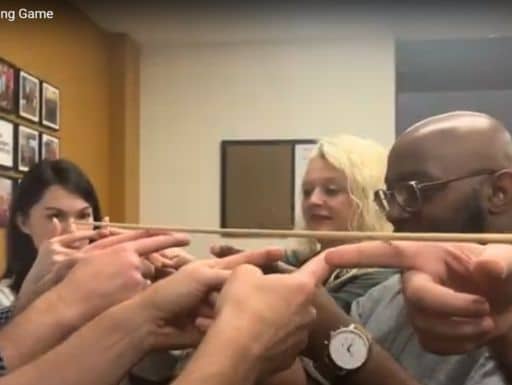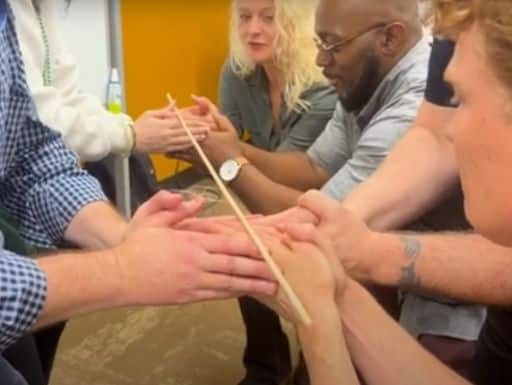Helium Stick Team Building Game

By the way, you can get these at any Home Depot, Lowes, Michael’s, Hobby Lobby, or Wal-Mart. And they only cost a few pennies each. You can usually find dowel rods in the woodworking section of home improvement stores or arts and crafts in discount stores.
Organize your group into small groups of eight to ten people. You’ll need at least six people per team to make it work. But more than eight or nine might get cumbersome.
Rules for the Helium Stick Team Building Game (Icebreaker).
Take a very thin dowel rod (the thinner the better). Hold it horizontally about chest height of the tallest person in the group. Then, ask the participants to hold the stick onto of their index fingers and lower it to the ground as a team.
Give them these rules for this team game:
- Every team member has to keep both index fingers in constant contact with the stick at all times. If even a single team member loses contact, the team has to start over at chest height again.
- The stick can only be resting on the index fingers. So team members can’t wrap a finger over the top of the stick or slide fingernails over the stick, etc. (They can’t force the stick down.)
- Every team member must be standing and the starting point is chest height of the tallest person.
You have to add the third rule or everyone will drop to their knees and try to cheat right away.
Once the teams begin to touch the stick, the challenge will present itself very quickly.
The stick is so light that the up-force from each of the fingers trying to stay in contact is greater than the weight of the stick.
So Immediately, the stick will begin to rise.
Many Team Members Will Quickly Try to Lead by Coaching (Or Ordering) Their Team Mates.

Inevitably, the stick will begin to rise. The coach(es) will then offer more stern guidance… “No, let’s go down! NO DOWN!” When that doesn’t work, they will get more vocal (because the problem is that everyone just isn’t listening to the leader, right?)
Finally, the team members will begin to lay blame. “Whose making the stick go up?” (Verbal leaders often point blame and yell at others when teams don’t follow their directions.)
After they struggle a while, take a break and analyze what has happened. Get them to try to figure out why the stick is rising.
If you want to coach them a little, try to get them to see how the multiple points of contact may be the problem.
Here Is the Solution to the Helium Stick Icebreaker.

To solve the challenge, the group must reduce the points of contacts with the stick. For instance, a single person can lower the stick very easily because he or she only has two points of contact (the two index fingers.) Once a second person is added, the task is much more difficult because now there are four points of contact. (The four index fingers.) Once you get to six people, there are now 12 points of contact.
So to solve the challenge, all that needs to happen is to have a single person one each side put his or her hands on the outside of all the hands of the other team members.
Now that person can lower the entire stack of hands at the exact same time.
Great Debriefs for this Team Game.
This is a fantastic team building game that can lead to fantastic debriefs.
For instance, early in the exercise, participants began to try to take charge and be the leader in the group. However, the leader became frustrated quickly because the team wasn’t following directions.
This exercise shows that real leaders lead by example — not by ordering their team around. You can also ask them questions about how each team solved the challenge.
For other team building icebreakers, visit our Resource Center!
